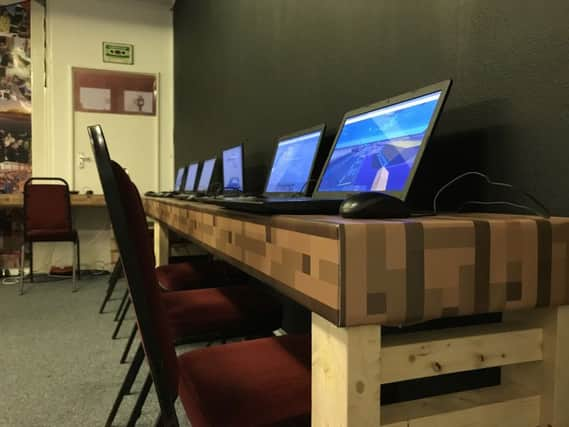Bringing Minecraft into the classroom


In recent years, this fundamental idea behind gaming has been revolutionising the ways we learn.
Think of a classroom, it’s where knowledge is shared and creativity is encouraged, but are the traditional ways of learning becoming outdated?
Advertisement
Hide AdAdvertisement
Hide AdChildren are growing up in an online era and education has begun embracing this fact.
Building blocks of knowledge
Society is on a mission to engage with young people and organisations such as Brighton-based BlockBuilders and London’s BlockWorks have been using Minecraft to do just that.
BlockBuilders use Minecraft to host environmental, historical and town planning workshops as an alternative to general teaching.
Co-founder Megan Leckie, said: “It gives kids the priority especially when we work with adults and parents. The kids are the experts and it gives a them a lot more confidence in what they’re saying.”
Advertisement
Hide AdAdvertisement
Hide AdBlockWorks use Minecraft to create games alongside digital learning and engagement experiences. Its efforts in education are focused around working with museums, galleries and creating interactive maps such as its fire of London exhibition.
Managing director James Delaney, said: “Feedback is always good because kids are pretty deprived of this stuff, they’re thrilled to have anything educational inside their favourite computer game.”
So what makes Minecraft a revolutionary education tool as opposed to traditional teaching? The concept empowers young people to dive into a platform they love and engage with, and organisations are factoring in models of local areas, reconstructions of history and creative learning environments.
Miss Leckie said: “Minecraft is a great and versatile 3-D design tool. When we show people the environmental projects we’ve done, you can change the environment and show the effect of it straight away. Whereas in real life it would take 30 years.”
Advertisement
Hide AdAdvertisement
Hide AdSocial expression in the classroom can also be a problem for young people with disabilities such as autism. Minecraft represents a learning medium where everyone is united in common interest and has the same tools at their disposal.
The kids are the experts
Technology is rapidly advancing and subsequently, so are the learning abilities of younger generations. Within Minecraft, the kids are the experts and is that such a bad thing?
Co-founder of BlockBuilders Joseph Palmer said: “Minecraft has a great reputation as its seen as being creative and something different.
“We did a study where kids had an hour lecture on the water cycle and we did a session using Minecraft, we built the local biosphere region and went through the elements of the water cycle. Compared to teacher centered teaching, Minecraft was able to boost their understanding by around 20 per cent.”
Advertisement
Hide AdAdvertisement
Hide AdIn a technological society where games like Fortnite dominate everyone’s screens, it’s refreshing to hear about the innovative steps being taken to use gaming as a platform to expand on complex subjects and empower kids to have their opinions heard. Some real-world applications include; creating a digital museum of town history, suggesting redevelopment plans for school grounds and redesigning cities.
Miss Leckie said they are asking Brighton residents what areas they think need changing. The kids then redevelop these areas in Minecraft and put those ideas forward to the council.
What’s next?
The idea that certain games can become learning platforms is controversial, perhaps due to depictions of games as distractions or simply as something you do to get away from the real world. A big realisation comes from Microsoft’s decision to buy Minecraft and begin pushing it as part of their school software packages.
Mr Palmer said: “If you started looking at Minecraft as something that can go into schools as a normal piece of technology, that can really flip the stigma around it.”
Advertisement
Hide AdAdvertisement
Hide AdConcerns over implementation are what seems to be the significant hurdle in fully welcoming video games into classrooms. It’s clear the kids are the experts, so what about the teachers?
Mr Delaney said: “We’ve done work with schools and you always get one or two teachers who are Minecraft mad and the others don’t want to hear about it. Because they have a fear, and quite rightly so, that the kids know more than them, which is true.”
Additionally, Miss Leckie said: “A lot of stuff they’re teaching in I.T is the same as when I was in school and that’s shocking since so much has changed since then.”
Perhaps the education element extends to teachers too, helping them understand the benefits of games such as Minecraft and begin to accept it as a learning platform rather than just a digital-take on Legoland.
Advertisement
Hide AdAdvertisement
Hide AdPerhaps this could be attributed to the generational gap and as time goes on, this may improve as today’s younger generations bring their digital experience to the world of teaching. Technology has advanced leaps and bounds over the decades and this presents a call for action from schools and teachers to keep up.
Whether you’re an organisation, teacher, parent or child, it’s an intriguing time as Minecraft continues its transition from bedrooms to classrooms, despite concerns over teacher training. Video games are a platform designed to engage, excite and empower young people and the education system is taking hold of that fact.